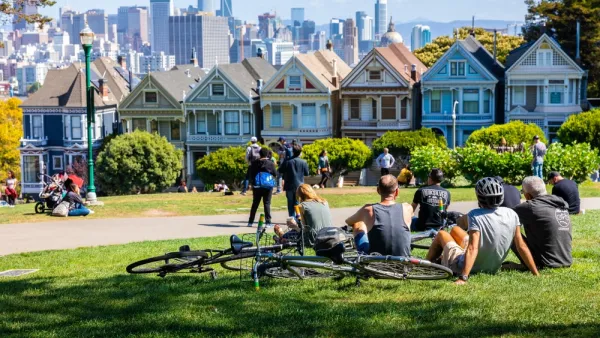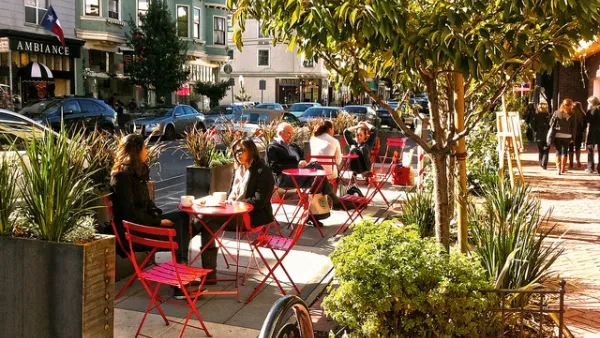As the number of completed parklets in San Francisco nears three dozen, after debuting only two years ago, "the latest trend in urban placemaking" has entered the planning mainstream without losing its grassroots origins.
John King of the San Francisco Chronicle revisits the city's startlingly successful parklet program, "where parking spaces are reborn as miniature public plazas," and describes how designs, and the program's popularity, have evolved over the past two years.
While "[s]ome early parklets were criticized for being little more than glorified cafe seating," newer designs range from one on California Street containing "LED lighting at night, while one on Mission Street in the Excelsior is adorned with painted wooden cutouts done by high school students," says King. "Planners now are pondering how to change parklets from isolated spaces - urbane nooks and crannies, so to speak - into something more systematic. Several could be concentrated on a single block, for instance, or a half dozen could map a path through a neighborhood."
With 31 such interventions either completed or under construction, and another 33 in the planning pipeline, parklets could bring about something more than just pretty spaces - they provide an opportunity to increase public participation in local communities. In San Francisco, parklets are often funded by local business and crowdsourcing (costing around $25,000), and constructed by neighborhood volunteers. According to King, "...the parklet emerging on Post Street shows the importance of having local residents bring a space to life, rather than simply providing input to city planners."
FULL STORY: SF parklets a homegrown effort

National Parks Layoffs Will Cause Communities to Lose Billions
Thousands of essential park workers were laid off this week, just before the busy spring break season.

Retro-silient?: America’s First “Eco-burb,” The Woodlands Turns 50
A master-planned community north of Houston offers lessons on green infrastructure and resilient design, but falls short of its founder’s lofty affordability and walkability goals.

Delivering for America Plan Will Downgrade Mail Service in at Least 49.5 Percent of Zip Codes
Republican and Democrat lawmakers criticize the plan for its disproportionate negative impact on rural communities.

Test News Post 1
This is a summary

Test News Headline 46
Test for the image on the front page.

Balancing Bombs and Butterflies: How the National Guard Protects a Rare Species
The National Guard at Fort Indiantown Gap uses GIS technology and land management strategies to balance military training with conservation efforts, ensuring the survival of the rare eastern regal fritillary butterfly.
Urban Design for Planners 1: Software Tools
This six-course series explores essential urban design concepts using open source software and equips planners with the tools they need to participate fully in the urban design process.
Planning for Universal Design
Learn the tools for implementing Universal Design in planning regulations.
EMC Planning Group, Inc.
Planetizen
Planetizen
Mpact (formerly Rail~Volution)
Great Falls Development Authority, Inc.
HUDs Office of Policy Development and Research
NYU Wagner Graduate School of Public Service




























